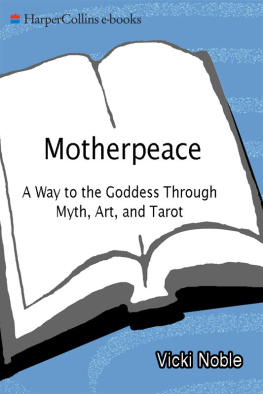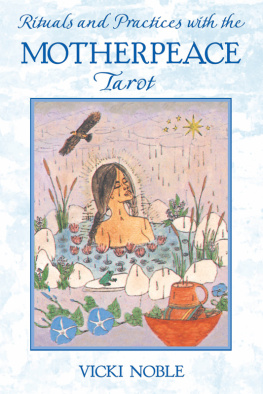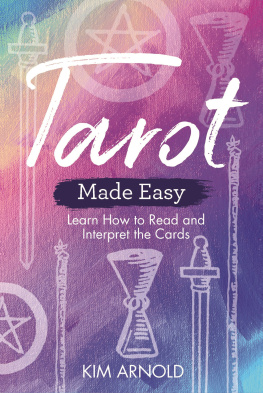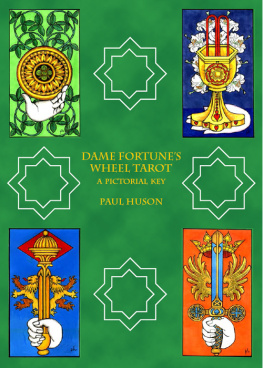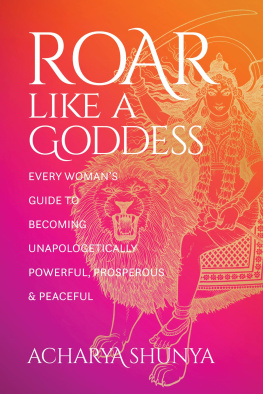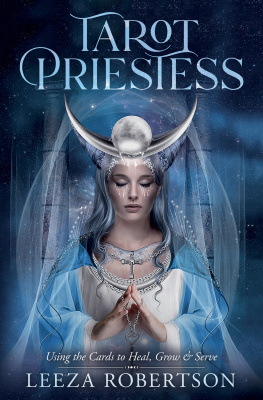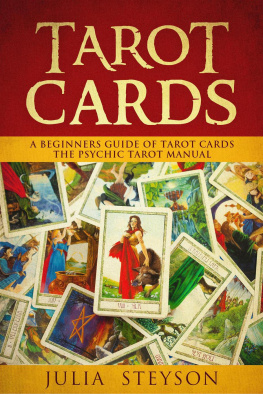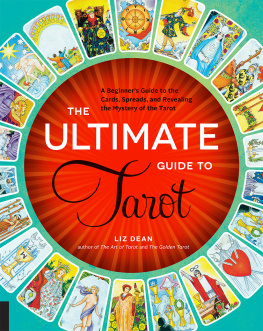PHOTO CREDITS:
Horned Goddess from Tassili in the Sahara: photo by Gerard Franceschi, copyright 1958 by Les ditions Arthaud, Paris, and reproduced by permission.
Goddess figures from Peche-Merle: reproduced from S. Giedion, The Eternal Present (1962) by permission of Princeton University Press.
Artist in Mithila, India: photo by Edouard Bourbat, reproduced by permission of Agence de Presse Rapho-TOP, Paris.
High Priestess card from Waite-Rider Tarot deck: copyright 1971 by, and reproduced by permission of, U.S. Games Systems, Inc., New York 10016.
Snake Quilt: in collection of the author, and reproduced by permission of the artist, Barbara Comstock.
MOTHERPEACE: A Way to the Goddess Through Myth, Art, and Tarot . Copyright 1983 by Vicki Noble. Foreword copyright 1994 by Vicki Noble. All rights reserved under International and Pan-American Copyright Conventions. By payment of the required fees, you have been granted the non-exclusive, non-transferable right to access and read the text of this ebook on-screen. No part of this text may be reproduced, transmitted, down-loaded, decompiled, reverse engineered, or stored in or introduced into any information storage and retrieval system, in any form or by any means, whether electronic or mechanical, now known or hereinafter invented, without the express written permission of HarperCollins ebooks.
All Motherpeace images copyright 1981 by Motherpeace, the pseudonym used by Vicki Noble and Karen Vogel as joint creators of the images, which are reproduced here by permission, and which are also available in the form of the Motherpeace Tarot cards. All rights reserved.
ISBN: 978-0-06-251085-3
An Earlier Edition of This Book Was Catalogued As Follows:
Noble, Vicki.
Motherpeace: a way to the goddess through myth, art, and tarot.
Bibliography: p. 257
Includes index.
1. Women and religion. 2. Spiritual life. 3. Tarot. 4. Tarot in art.
5. Goddesses. I. Title.
BL458.N63 1982 291.211 82-47752
08 09 10 11 12 RRD(H) 10 9 8 7 6 5 4 3 2 1
EPub Edition JUNE 2013 ISBN: 9780062299499
The Motherpeace Tarot cards sprang into being during a visible and documented wave of feminist and shamanic creativity that swept the country during the late 1970s. Inspired, Karen Vogel and I conceptually split the Tarot deck in half and began to draw pictures, taking one year to complete the seventy-eight original black-and-white line drawings that were to become the Motherpeace cards. Having never drawn pictures before, we were both amazed and incredulous at the process. It was the most fun I had ever hadsitting down each day to a blank piece of art paper and, beginning with no more than a concept, manifesting yet another image. I went into a trance and lost track of time, immersing myself in sacred thoughts, images, and feelings for hours at a sitting. When the sun set each afternoon, taking the necessary light with it, I would force myself to stop. It was positively ecstatic work.
By the time I sat down to write the Motherpeace book in early 1982, I simply placed in front of me whichever card I was going to discuss that day and immersed myself in it visually. With research books gathered all around me, I began to write about each card, drawing from the image itself and the inspiration it provided. In this way, the language that I used to write the Motherpeace book was my own, rather than the traditional, often obscure, and stilted Tarot language that I had attempted to use in the beginning. It made all the difference: The material poured through me as if I were a funnel; I merely gave it focus and put it on the page. Just as drawing the cards had been inconceivably pleasurable, writing the book was ecstatic work as well.
Women from around the world have told me that they cant use other Tarot decks or books because they find them too negative, too patriarchal, or too heavy. But Motherpeace speaks their language, relates to their experiences, and gives them a friendly response when they ask for help. And Motherpeace is original in that it contains multiracial and multicultural images as well. Motherpeace: A Way to the Goddess has sold over 100,000 copies since it came out in 1983, a testimony to our felt need for a woman-identified Tarot.
I wish I could say that the introduction I wrote to the Motherpeace book in 1983 has become obsolete, and that what was radical and exciting to me at that time has now become run-of-the-mill, humdrum, old information. Instead, I read it now with a kind of sadness, because I see that the past decade has done more to erase the scholarship included here in these pages than to validate it. Even with the incredible work of Marija Gimbutas and other vibrant scholars of shamanism and prehistory, the general public has been led to believe that the problems I speak of here are no longer active, and the solutions no longer necessary; we are now postfeminist. People have been lulled to sleep by the Nixon-Reagan-Bush years of brainwashing and the whitewashing of reality, rendering the material in this book as fresh today as the day it was written; the only difference is that there is a much greater urgency in it today.
The Motherpeace images have as much application in our lives now as they ever did, if not more. We desperately need to awaken to the cries of the earth and her creatures before it is too late, and our unconscious denial of their plight is symptomatic of our unwillingness as a culture to make the necessary changes. It is the right brain, or intuitive mind, that can feel and hear and respond to these cries, and Motherpeace is all about how to open and develop this faculty to its fullest.
Vicki Noble
Berkeley, Candlemas 1994
Motherpeace was written as if I were talking with four particular friends. In this diverse group, the first friend is a feminist sister who, in addition to the struggles to improve the quality of our everyday lives, wants to recover a vision of the Goddess and the kind of society that would honor her.
My second friend uses a traditional Tarot deck, as millions do, but is excited to hear about a wholly new set of Tarot images that, while drawing upon tradition, recast it to embody more fully the lives and aspirations of women.
While working on the book, I also kept in mind a third friend. Strongly visual, she records and meditates on her dreams and, like others influenced by Jung, seeks to deepen her knowledge of myth as a way of understanding her own psyche and the dramas being acted out around her.
This brings us to the fourth member of my imaginary audiencea friend who is deeply concerned about the lack of peace in the world and, in particular, about the numbing prospect of a nuclear exchange. No longer believing that the system will cure itself, he wants to explore visions of society other than the patriarchal one now dominant.

